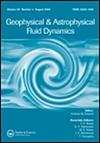Wave–vortex interactions and effective mean forces: three basic problems
IF 1.1
4区 地球科学
Q3 ASTRONOMY & ASTROPHYSICS
Geophysical and Astrophysical Fluid Dynamics
Pub Date : 2020-04-27
DOI:10.1080/03091929.2020.1753723
引用次数: 0
Abstract
Abstract Three examples of wave–vortex interaction are studied, in analytically tractable weak refraction regimes with attention to the mean recoil forces, local and remote, that are associated with refractive changes in wave pseudomomentum fluxes. Wave-induced mean forces of this kind can be persistent, with cumulative effects, even in the absence of wave dissipation. In each example, a single wavetrain propagates past a single vortex. In the first two examples, in a two-dimensional, non-rotating acoustic or shallow-water setting, the focus is on whether or not the wavetrain overlaps the vortex core. In the overlapping case, the recoil has a local contribution given by the Craik–Leibovich force on the vortex core, the vector product of Stokes drift and mean vorticity. (For a quantum vortex this contribution is called the Iordanskii force arising from the Aharonov–Bohm effect on a phonon current.) However, in all except one special limiting case there are additional “remote” contributions, mediated by Stokes-drift-induced return flows that can intersect the vortex core well away from locations where the waves are refracted. The third example is a non-overlapping, remote-recoil-only example in a rapidly rotating frame, in which the waves are deep-water gravity waves and the mean flow obeys shallow-water quasigeostrophic dynamics. Contrary to what might at first be thought, the Ursell “anti-Stokes flow” induced by the rotation – an Eulerian-mean flow tending to cancel the Stokes drift – fails to suppress remote recoil. There are nontrivial open questions about extending these results to regimes of stronger refraction, especially regarding the scope of the “pseudomomentum rule” for the wave-induced recoil forces.波涡相互作用和有效平均力:三个基本问题
摘要研究了在解析可处理的弱折射条件下,波涡相互作用的三个例子,并考虑了与波伪动量通量的折射变化相关的局部和远端平均反冲力。这种由波浪引起的平均力可以是持久的,具有累积效应,即使在没有波浪耗散的情况下。在每一个例子中,一个单一的波列通过一个单一的涡旋传播。在前两个例子中,在二维、非旋转声学或浅水环境中,重点是波列是否与漩涡核心重叠。在重叠情况下,后坐力的局部贡献来自于涡旋核上的Craik-Leibovich力、Stokes漂移和平均涡量的矢量积。(对于量子涡旋,这种贡献被称为由声子电流上的阿哈罗诺夫-玻姆效应产生的约当斯基力。)然而,除了一个特殊的极限情况外,在所有情况下都有额外的“远程”贡献,由斯托克斯漂移引起的回流介导,这些回流可以在远离波折射位置的地方与漩涡核心交叉。第三个例子是一个快速旋转框架中的非重叠、仅远程后坐力的例子,其中波是深水重力波,平均流服从浅水准地转动力学。与最初的想法相反,由旋转引起的乌塞尔“反斯托克斯流”——一种倾向于抵消斯托克斯漂移的欧拉平均流——未能抑制远程后坐力。关于将这些结果推广到更强折射的情况,特别是关于波致反冲力的“伪动量规则”的范围,存在一些重要的开放问题。
本文章由计算机程序翻译,如有差异,请以英文原文为准。
求助全文
约1分钟内获得全文
求助全文
来源期刊

Geophysical and Astrophysical Fluid Dynamics
地学天文-地球化学与地球物理
CiteScore
3.10
自引率
0.00%
发文量
14
审稿时长
>12 weeks
期刊介绍:
Geophysical and Astrophysical Fluid Dynamics exists for the publication of original research papers and short communications, occasional survey articles and conference reports on the fluid mechanics of the earth and planets, including oceans, atmospheres and interiors, and the fluid mechanics of the sun, stars and other astrophysical objects.
In addition, their magnetohydrodynamic behaviours are investigated. Experimental, theoretical and numerical studies of rotating, stratified and convecting fluids of general interest to geophysicists and astrophysicists appear. Properly interpreted observational results are also published.
 求助内容:
求助内容: 应助结果提醒方式:
应助结果提醒方式:


